How online grocery is adapting to the challenge of surging sales

Online grocery sales growth is skyrocketing--but keeping up with the demand is challenging for any online grocery business. In this blog we'll explore the latest online grocery trends and give you 5 tips for how successful online grocery stores are adapting to surging demand.
Online grocery businesses are experiencing unprecedented global demand, much of it from first-time consumers.
This presents challenges in online grocery. eGrocery has website difficulties that are unique in online retail, such as long session durations and complex delivery requests. It puts overwhelming stress on online grocery websites and supply chains that risks poor customer experiences, lost orders, and wasted resources when staff are already stretched thin.
In this blog we review recent online grocery sales growth, how demand is straining eGrocery, and end with 5 tips for how successful online grocery stores are adapting to surging demand. Let's dig in.
- Is online grocery sales growth finally coming to Europe & North America?
- Recent surges in demand to online grocery stores
- Overwhelming demand is straining eGrocery
- This risks giving new customers a poor experience
- Why are online grocery store websites struggling to keep up with demand?
- What can online grocery stores do to manage the demand?
Is online grocery sales growth finally coming to Europe & North America?
When it comes to online groceries, consumers in Europe and North America have lagged behind their counterparts in Asia. In South Korea, nearly 1 in 5 grocery items was purchased online in 2018, according to data analyst Kantar. In the U.S., it was less than 1 in 20.
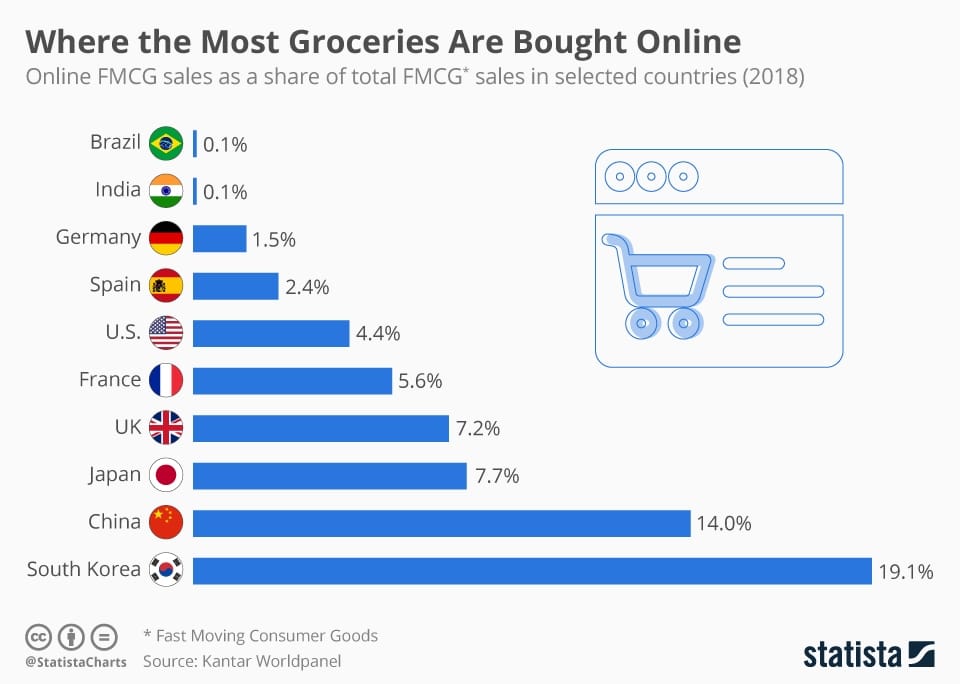
But the industry has been primed for growth in Europe and North America, in part because online grocery is starting at a low point and in part because of changing consumer sentiment.
For instance, U.S. online grocery was set to grow 18.2% in 2019 and be the fastest-growing category in all of ecommerce, according to a 2019 eMarketer report.
According to Business Insider, by 2021 the majority of Americans will have tried online grocery shopping, more than doubling market penetration in 2019.
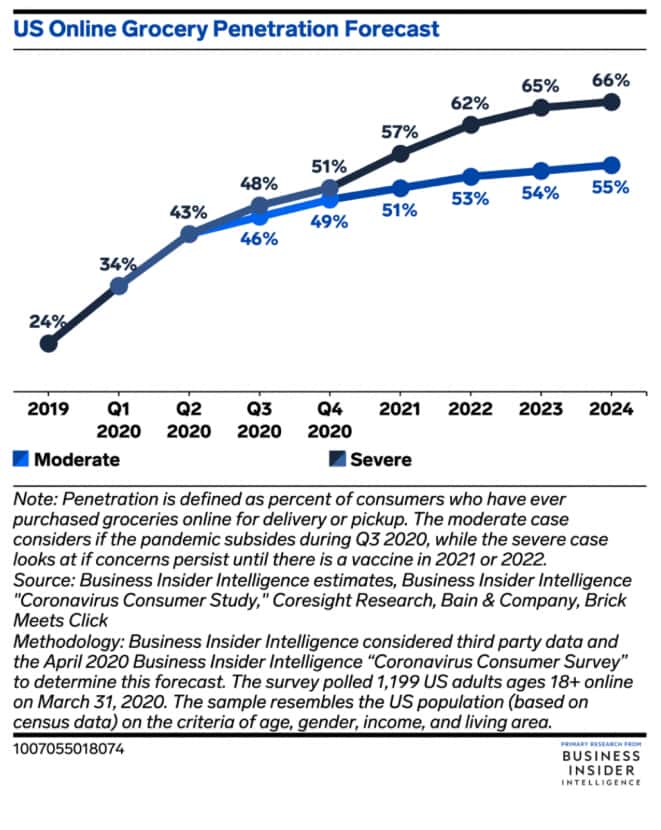
And U.S. online grocery sales are projected to more than double over the next five years, from $50 billion in 2020 to $118 billion in 2025.
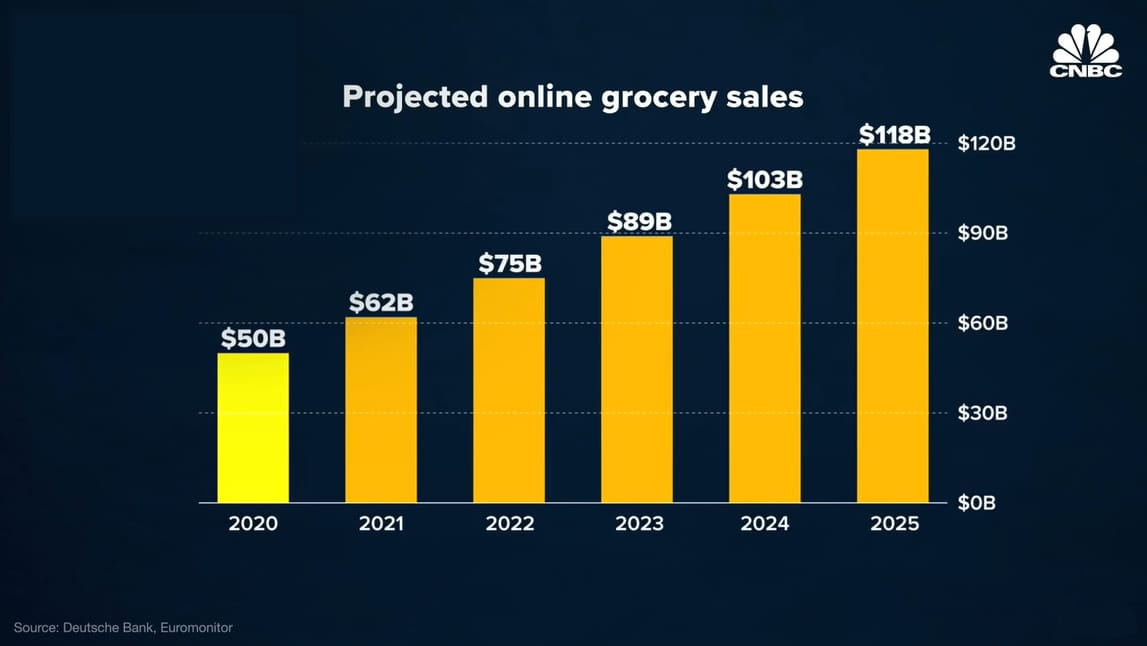
Recent surges in demand to online grocery stores
But the coronavirus pandemic and shifting consumer behavior have prompted customers to give online grocery stores a second look, adding to the already-anticipated growth.
This should come as no surprise, given the surging demand to Asian grocery stores we saw in early 2020:
- Chinese online grocer Missfresh saw a four-fold increase in orders from Jan 25-30 compared to the same time last year.
- And JD.com reported 215% increase in perishable item purchases from Jan 24 – Feb 2 compared to the same period in 2019.
We've since seen similarly unprecedented demand for online groceries in Europe and North America.
- In Italy, supermarket chain Carrefour said that its Italian customers had doubled, to 110,000, in early March.
- In France, the first week of March saw online grocery orders for home delivery soar 32% while click-and-collect rose 29 percentage points according to Nielsen Research.
- In the U.S., Walmart’s online grocery saw weekly sales growth of over 60% in February and March, measured year-over-year. Instacart saw customer order volume skyrocket 500% year-over-year. Instacart, Walmart Grocery and Shipt have seen respectively 218%, 160%, and 124% increases in average daily downloads of their apps compared to the previous month.
- US. online grocery shopping overall saw a boost of 110% in daily sales in April 2020.
- Also in the U.S., smaller upscale grocery businesses are seeing similar surges in demand. For example, Lunds & Byerly’s in Minnesota and Farmstead in California have seen online orders and revenue double in recent weeks. The online channel is making up 90% of overall business for some independent grocers, a paradigm shift from normal operations.
Instacart President Nilam Ganenthiran perhaps summed up best the rapid shift to online grocery when he said: “We are seeing grocery adoption that should have taken 5 years, or what we expected to take 5 years, happen in the last 5 weeks.”
"We are seeing grocery adoption that we expected to take 5 years happen in the last 5 weeks."
Overwhelming demand is straining eGrocery
All this demand puts overwhelming stress on online grocery store websites. As a U.K. online grocer CFO said recently, “the amount of demand is simply unprecedented,” comparing the surge in website traffic to a “denial-of-service attack”.
A U.K. online grocer CFO compared the scale of the surge in website traffic to a "denial-of-service attack"
Many online grocery retailers have seen their websites crash due to the overwhelming demand. Articles like “Grocery Delivery Strains to Meet Voracious Demand”, “Surging Demand Overloads Online Grocers”, and “’We’re Putting Out Fires’: Companies Adjust to Online Grocery Surge” are all over mass media and industry press.
According to one survey, only 1 in 5 of Americans who tried to order groceries online were able to do so without experiencing any issues or delays.

To be clear, there are many reasons why online grocery stores are struggling to keep up with demand other than their websites. Labor shortages, delivery costs, and supply chain issues all contribute.
But without a functioning website, no orders roll in at all. And many online grocery stores have seen their websites struggle to manage the surge in demand.
This risks giving new customers a poor shopping experience
The sudden surge in interest for online groceries presents an opportunity for online grocery retailers to prove their value to consumers in the short term. It critically also offers online grocery stores a chance to welcome new shoppers so important to long-term success.
“Many people are going to be exposed to online grocery for the first time,” says Bain & Co. retail expert Joëlle de Montgolfier. “It should result in an acceleration in a category that has long resisted going online.”
And early data indicates she’s right. According to a Gordon Haskett Research Advisors survey on March 15th, one third of U.S. consumers had bought online groceries in the previous seven days. Crucially, 41% of respondents said they were buying groceries online for the first time.
41% of U.S. consumers said they were buying groceries online for the first time, according to a new survey
It’s imperative for online grocery stores to give these new consumers a good first impression if they are going to cement behavior change and brand loyalty for when things return to normal.
As Business Insider writes, “the online grocery services that are best able to handle surging order volume will likely be the most popular services after the pandemic subsides because consumers will be able to rely on those services to consistently bring them groceries.”
Online grocery services that are best able to handle surging order volume will likely be the most popular services after the pandemic
And ideally in the short term, online grocery can make up for decreases in in-store shopping, as brick and mortar stores close and consumers minimize their trips to open ones. When China’s largest hypermarket, Sun Art, had to close 80% of their locations to comply with government lockdown orders, they were able to keep their revenue steady by diverting orders to their websites and capturing orders online.
But, online grocery can neither be a positive customer experience nor a financial life raft for companies if the online grocery store’s website isn’t functioning.
Why are online grocery store websites struggling to keep up with demand?
Scaling the website to keep up with demand may seem like the smallest hurdle for online grocery stores. But the devil is in the details. Scaling an ecommerce website is technically complex, because just like a physical store, every website has capacity limits. When website traffic exceeds this capacity limit, the site is liable to slow down and crash.
Related: How High Online Traffic Can Crash Your Website
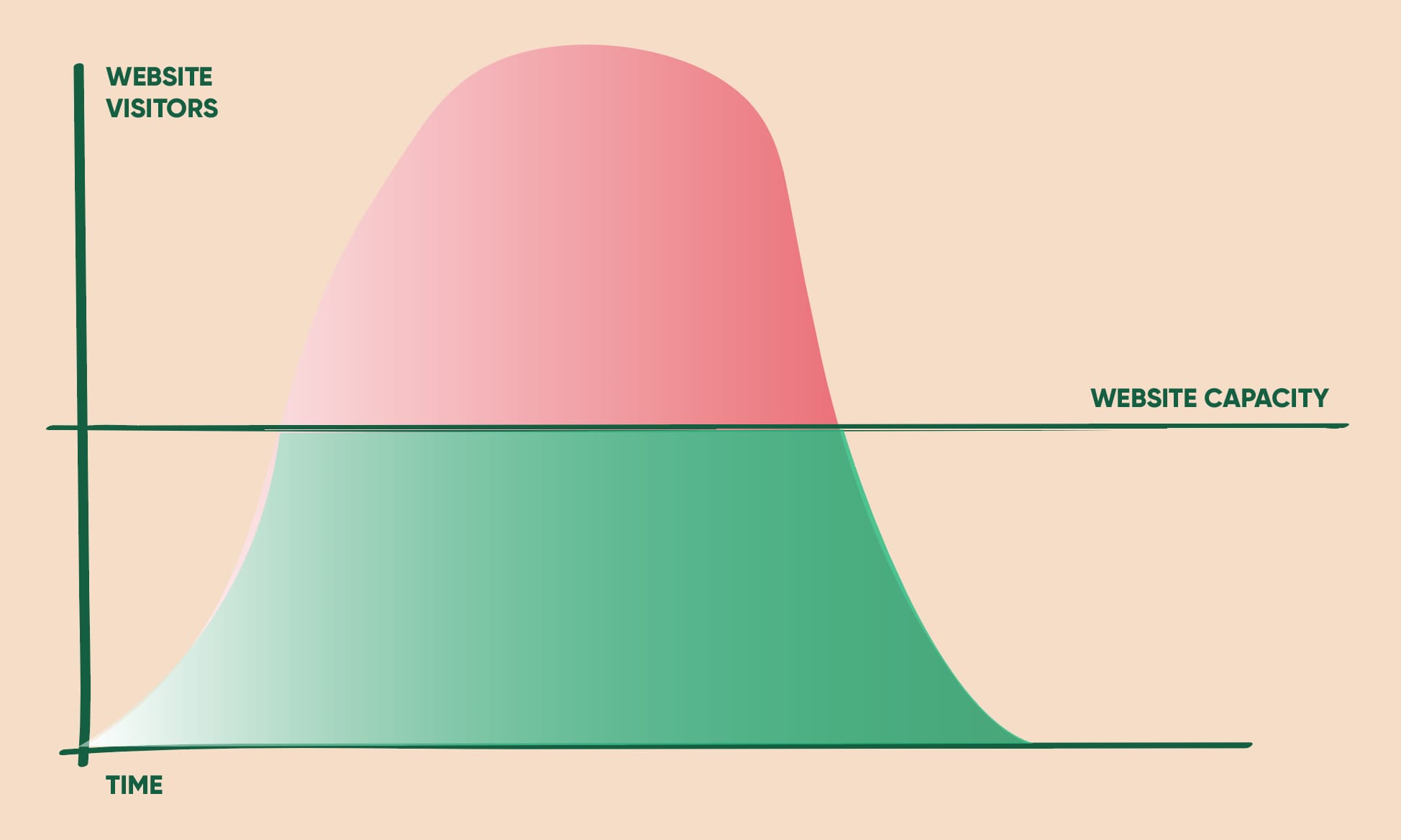
Bottlenecks are the weakest link
Bottlenecks are where a website breaks down, and ecommerce websites have a couple bottlenecks that are notoriously hard to scale:
1. The payment gateway. Credit card purchases are processed using these third-party services. The gateways perform a variety of technical checks and verifications to process secure financial transactions. As a result, they normally have a relatively inflexible rate at which they can process transactions, often far below what your own website can manage. There’s nothing more frustrating for a customer than putting the time and energy into making their eGrocery order only to have the order fail at payment.
2. The inventory system. When shoppers add products to their carts, that requires database function calls to update inventory remaining for other shoppers. Depending on the website setup, shoppers may only have their products guaranteed for a set timeframe. When the time runs out, the lock is removed from the product and inventory is updated accordingly. All this requires synchronization and functions that impact server performance.
Online grocery store websites have unique challenges
3. Arranging delivery and pickup. This yet another major bottleneck online grocery stores have to contend with. The logistics involved in choosing a curbside pickup window and coordinating with delivery services is far more resource-intensive than shipping a package in the mail as most online retailers do. Like the payment gateway, this step often involves integration with a third party, who has capacity limits of their own that by extension limits how many customers a website can process.
Long session duration is another special challenge for online grocery retailers, as customers browse and purchase many more individual items than in traditional online retail.
According to analysis of 92 million sessions globally in 2018, ContentSquare found online grocery shoppers had by far the longest session duration—at 7.1 minutes on desktop—of the 7 verticals analyzed.
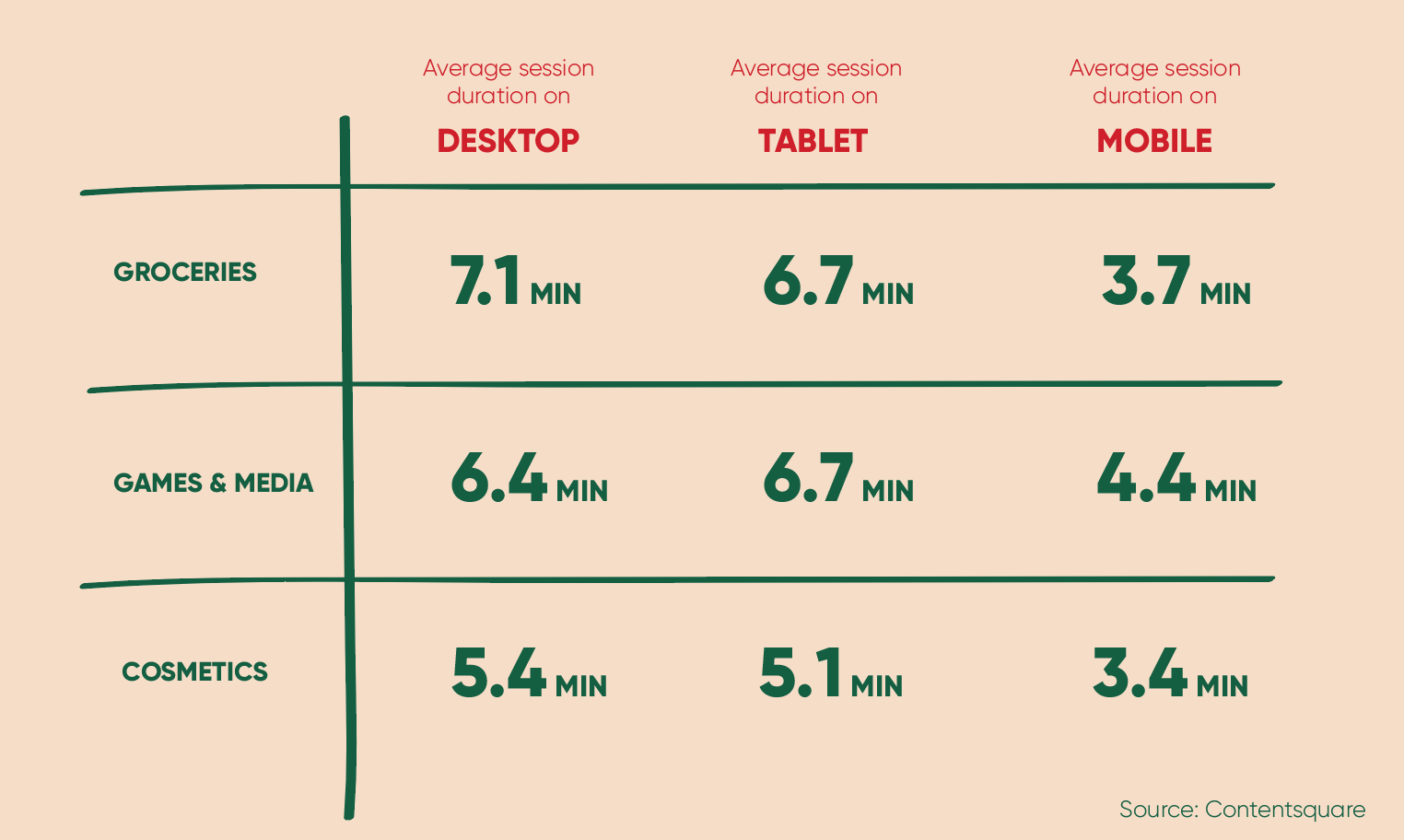
This is important because the longer time that a customer spends on the website, the lower the arrival rate can be to keep the website performing smoothly.
According to Little’s Law, if a website could handle 80 visitors, and they on average spent 5 minutes on the website, 16 visitors could arrive each minute and the website would perform fine. However, doubling the average time spent on the website to 10 minutes would cut the arrival rate in half, to 8 visitors per minute, to keep things in balance.
Part of the problem is that one must account for the distribution of shoppers on a site to be sure to avoid crashing. 80 visitors spread throughout the website and 80 visitors trying to check out simultaneously incur two vastly different loads on the website.
Related: How to Avoid the Website Capacity Mistake Everyone Makes
What can online grocery stores do to manage the demand?
There is no one silver bullet to solve the challenge of handling surging demand. But there are several steps which, if combined, can put you in control of your website’s performance.
1. Scale up servers
Scaling up or autoscaling your servers is a natural first step in handling growing demand, and one you should take. Doing so can buy you some of the extra capacity you need.
But understand there are limits.
Scaling servers doesn’t mean all parts of the website can scale equally well. And stepping up server capacity doesn’t address 3rd party overload limits of payment gateways or delivery systems. Scaling up is just one step you need to take.
Related: Autoscaling Explained: Why Scaling Your Website Is So Hard
2. Implement a CDN
Caching is one of the most effective and least expensive ways to improve scalability and performance.
A content delivery network (CDN) will take the strain of loading images and product pages off your servers, freeing them up to do the performance-intensive work of dynamic calls, check out, and payment.
In 2020, a CDN is truly a must-have for online retailers.
3. Swap out intensive features
It is better to have a responsive, basic website than an unavailable, feature-rich one.
Toggle off performance-intensive, “nice to have” features like the “Recommended for you” panels and advanced search functionality.
Similarly, if you load all images at once, consider instead to use lazy loading to load media on demand. According to Google, visitors perceive sites that load this way as faster, even if the actual load times are comparatively slow.
4. Analyze where the traffic is coming from
Using Google Analytics or your preferred website analytics tool, get a sense of where your visitors are coming from. If your website is already receiving more traffic than it can handle, do you need to continue running those Facebook ads?
Coordinate with your marketing team and any partners who may be promoting your company to make sure they understand what the website can handle and aren’t adding fuel to the fire.
5. Use a virtual waiting room
A virtual waiting room lets you control the rate at which visitors enter your website. This allows you to sell at your website and app’s maximum capacity without overshooting the threshold and crashing your site.
You can use your virtual waiting room as a safety net by only having it kick in when traffic exceeds your website’s thresholds. In the event your website or app get a surge in traffic, it places visitors in a first-in, first-out online queue to keep your bottlenecks from becoming overloaded.
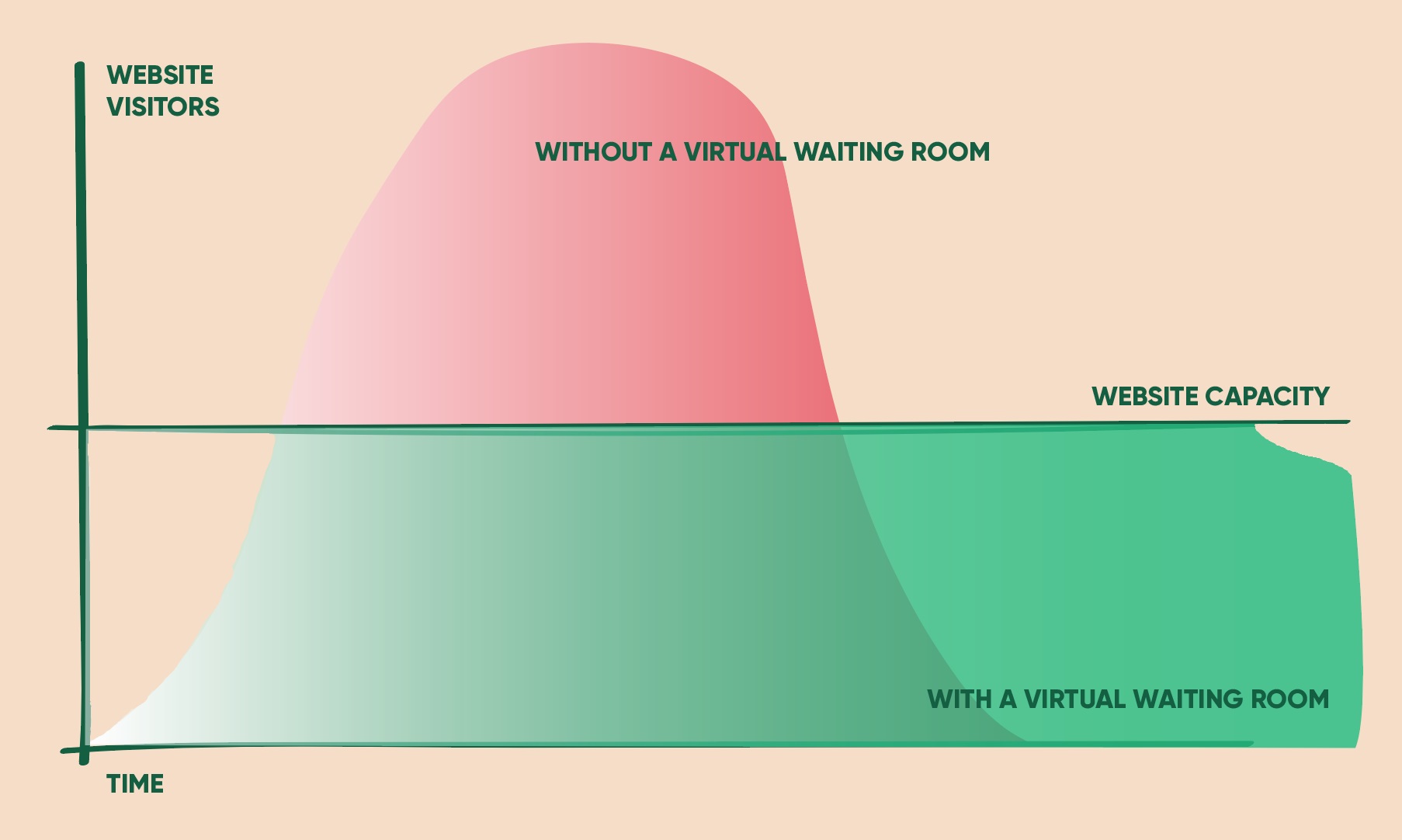
These technical tools will help you manage a surge in demand, but don’t forget about the importance of non-technical tools too: namely, communication.
Clear communication with your customers is the best way to set expectations and can make the difference between high frustration and empathetic understanding.
And don’t forget the human team that runs your online grocery store. Confirm that all departments are in sync and ensure there are clear escalation paths and assigned point-people should your website begin to experience issues.
(This post has been updated since it was originally written in March 2020.)